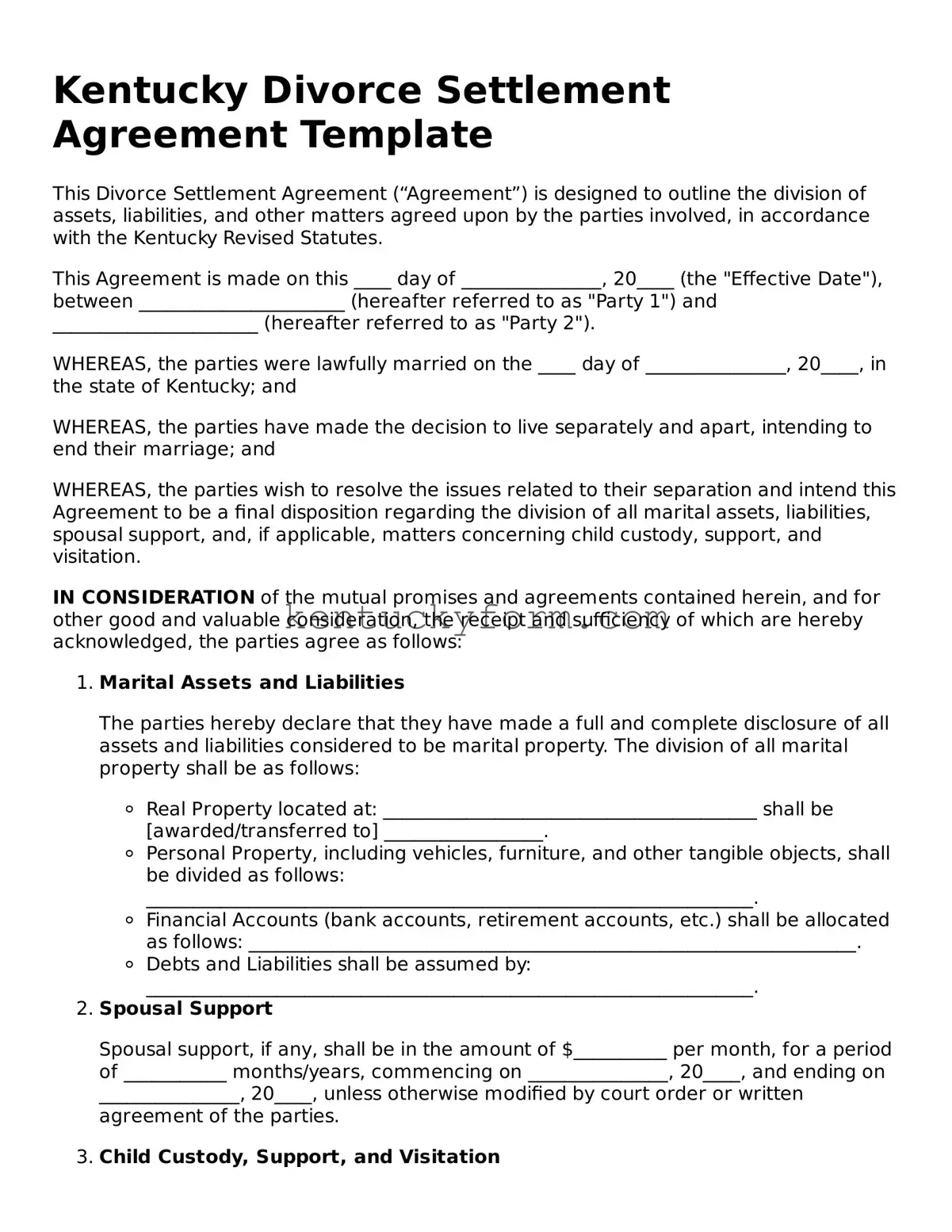Kentucky Divorce Settlement Agreement Template
This Divorce Settlement Agreement (“Agreement”) is designed to outline the division of assets, liabilities, and other matters agreed upon by the parties involved, in accordance with the Kentucky Revised Statutes.
This Agreement is made on this ____ day of _______________, 20____ (the "Effective Date"), between ______________________ (hereafter referred to as "Party 1") and ______________________ (hereafter referred to as "Party 2").
WHEREAS, the parties were lawfully married on the ____ day of _______________, 20____, in the state of Kentucky; and
WHEREAS, the parties have made the decision to live separately and apart, intending to end their marriage; and
WHEREAS, the parties wish to resolve the issues related to their separation and intend this Agreement to be a final disposition regarding the division of all marital assets, liabilities, spousal support, and, if applicable, matters concerning child custody, support, and visitation.
IN CONSIDERATION of the mutual promises and agreements contained herein, and for other good and valuable consideration, the receipt and sufficiency of which are hereby acknowledged, the parties agree as follows:
- Marital Assets and Liabilities
The parties hereby declare that they have made a full and complete disclosure of all assets and liabilities considered to be marital property. The division of all marital property shall be as follows:
- Real Property located at: ________________________________________ shall be [awarded/transferred to] _________________.
- Personal Property, including vehicles, furniture, and other tangible objects, shall be divided as follows: _________________________________________________________________.
- Financial Accounts (bank accounts, retirement accounts, etc.) shall be allocated as follows: _________________________________________________________________.
- Debts and Liabilities shall be assumed by: _________________________________________________________________.
- Spousal Support
Spousal support, if any, shall be in the amount of $__________ per month, for a period of ___________ months/years, commencing on _______________, 20____, and ending on _______________, 20____, unless otherwise modified by court order or written agreement of the parties.
- Child Custody, Support, and Visitation
If applicable, matters related to custody, support, and visitation of the minor child(ren) of the marriage are addressed as per a separate agreement or as follows:
- Custody of the child(ren) is awarded to: _________________________________________.
- Child support shall be paid by _____________________ in the amount of $__________ per month, in accordance with Kentucky child support guidelines, commencing on _______________, 20____.
- Visitation schedules are as follows: _____________________________________________.
- Miscellaneous
Any disputes arising under or in connection with this Agreement shall be settled by arbitration in the state of Kentucky, in accordance with the rules then existing of the American Arbitration Association, and judgment upon the award rendered may be entered in any court having jurisdiction thereof.
- Entire Agreement
This Agreement constitutes the entire agreement between the parties with respect to the subject matter hereof and supersedes all prior agreements, whether written or oral. No modification, amendment, or waiver of any of the provisions of this Agreement shall be effective unless in writing and signed by both parties.
- Governing Law
This Agreement shall be governed by and construed in accordance with the laws of the Commonwealth of Kentucky, without regard to its conflict of laws principles.
IN WITNESS WHEREOF, the parties have executed this Agreement as of the Effective Date first above written.
______________________________________
Signature of Party 1
Date: ___________________
______________________________________
Signature of Party 2
Date: ___________________
